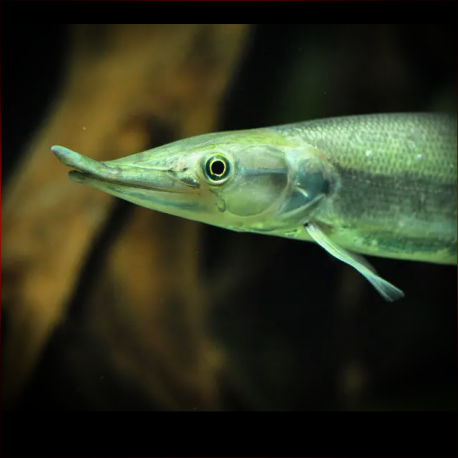More info
Datasheet
| Minimum Tank Size | 10000 litres / 2641.72 US gallons |
| Maximum Size | 80.0cm / 31.50inches |
| Temperature | 22°C / 71.60°F - 28°C / 82.40°F |
| Hardness | 1.01dgH / 18ppm - 12.05dgH / 215ppm |
| pH | 5.0-7.5 |
General Description: Boulengerella Cuvieri, commonly known as "Pirá-pacu," is a predatory fish species that thrives in the pelagic regions of main river channels, larger tributaries, and floodplain lakes in the Amazon basin. It exhibits sexual maturity at a size of around 250 mm SL, with the reproductive season typically falling between November and March. The species varies in appearance across its range, with darker specimens found in regions like the Río Orinoco, Guyana, and French Guiana.
Aquarium Setup: The Boulengerella Cuvieri species requires a tank size of at least 10,000 liters, with a setup that includes floating or overhanging vegetation for surface cover. Maintaining stable water conditions is crucial, necessitating the use of external filters, powerheads, and airstones. Regular 30-50% water changes are essential to ensure proper oxygen levels and water quality. Due to their jumping behavior, a tight-fitting tank cover is recommended. Additionally, covering the back and sides of the aquarium can help prevent the fish from colliding with the glass, especially in confined spaces.
Behaviour: Known for its peaceful nature towards larger tankmates and conspecifics, Boulengerella Cuvieri prefers to be kept in groups of four or more. It exhibits a schooling instinct in juveniles, while older individuals may display more solitary behavior but still group together intermittently. However, the species can become territorial in the presence of aggressive or competitive fish species, making careful selection of tankmates essential. It is best housed with similarly-sized fishes such as Cichla spp. and larger doradid or loricariid catfishes.
Feeding and Diet: Boulengerella Cuvieri is an obligate predator that primarily feeds on smaller fishes and insects in the wild. In captivity, the species readily accepts a diet of bloodworms, small earthworms, prawns, mussels, and various types of fish flesh. It is important to avoid feeding mammalian or avian meat like beef heart or chicken, as these can lead to health issues. Live feeder fish should also be avoided due to the risk of disease transmission, with a preference for properly conditioned alternatives with high nutritional value.
Reproduction & Dimorphism: Information regarding the reproduction of Boulengerella Cuvieri is unrecorded. However, sexual maturity is attained at approximately 250 mm SL, marking the initiation of the reproductive season between November and March. The species may exhibit dimorphic characteristics during certain life stages, with juveniles showcasing a schooling behavior, while older individuals tend towards more solitary habits.
Habitat and Distribution: Boulengerella Cuvieri is native to the Amazon basin, ranging from the Río Nanay in Peru to Amapá state in Brazil, the Río Orinoco in Venezuela, and coastal drainages in countries like Guyana, Suriname, and French Guiana. The fish prefers pelagic habitats in flowing river channels, tributaries, and floodplain lakes, where it coexists with various other fish species, particularly during its reproductive season.

